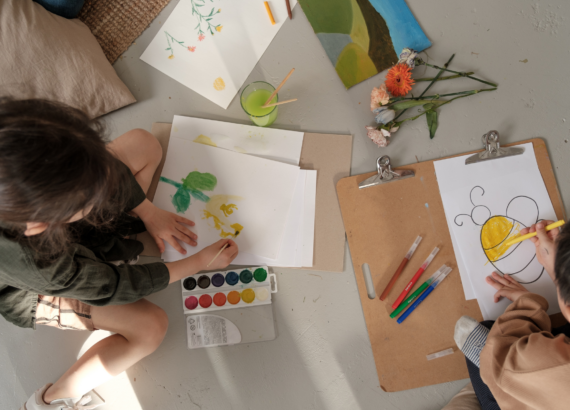Incorporating Heritage & Values into a Child’s Play Space
Amy Devins |
This summer, my parents told me to look through some boxes they had been safekeeping in their upstate New York home. They said there were some things that may interest me for my daughter. There were indeed, and my favorite was a tiny gingham apron.
I remembered it immediately: I had worn it as a child as I helped my own homemaker mom set the table for dinner or snuck raw dough from her sheets of Christmas cookies that hadn’t made it to the oven yet. It had been hand-sewn by my own grandmother, who, I now realize, was surely inspired by the gingham fashion of her own era of homemaking in the 1950s.
At the end of August, the apron followed me, my French husband and our French-American daughter on our flight back to France, where we live eight to nine months of the year. Upon our arrival, I decided to begin my search for a little play kitchen for our toddler. After all, she adores watching me cook, often mimicking my gestures as I stir batter or scoop sauce from a bowl; or trying to sneak a taste with her finger in the same way I did all those years ago.
To begin my search that weekend, I roamed the stores and the Internet, but I couldn’t bring myself to make a purchase. There was something off-putting about the mass-produced ones that every other child would have, and my impression that they weren’t built to last.
A moment of pure coincidence: a friend approached me that very Monday and told me that her daughters were too old for their wooden play kitchen now.
“It’s twenty years old,” she told me, “and I’ve personalized it over the years. Would you like it for your kid?”
I accepted, immediately loving the idea of repurposing something that had meant so much to someone else’s family (I was also aware of this co-worker’s talent for refurbishing old furniture, a gift I don’t naturally have).
An attraction to possessions that are unique, economical, well-made and full of meaning is probably in my blood. My ancestors immigrated to the U.S. in the early 20th century. Mostly through economic necessity, they embraced certain American values: they were experts in thriftiness, depended on and participated in acts of generosity and solidarity with their communities to get by, and worked hard to provide for their families. They also embraced their new home without forgetting to pass down fascinating and unique stories about our family’s past. This probably influenced my interest in history and historical objects beginning when I was a small child.
Fast-forward many years later, where I now find myself in Europe, the same continent as my ancestors, with a family of my own to nurture. My husband and I have managed to maintain a balance between both the French and American cultures and language in our home. Our relationship is all the richer for it, and my daughter could benefit from the best of both worlds. Therefore, the question that guides my motherhood and homemaking is the following:
How can I create a home that will provide a bilingual, bicultural atmosphere for my family, while not compromising on the most important American values I learned from my ancestors?
Perhaps this new little wooden kitchen, a thrifty hand-me-down, interested me more than anything in the stores or on the Internet because it was reminiscent of the values my ancestors needed to the make the U.S. their home.
It was certainly sturdy and well-built, even more so thanks to my friend’s hard work. She had made it unique: she repainted it, covered certain parts in wallpaper, then added knobs, hooks, doors and other details.
“The girls were reluctant to give it away at first,” she explained when we went to pick it up. “But we had a good discussion about how it will make another little child happy. It started a whole conversation about generosity and solidarity and how it makes the world better!”
I brought it home, along with the simple but elegant wooden toys that came along with it. I chose the corner of our kitchen so that my daughter could “cook” alongside me. Then I pulled out the little gingham apron and decided that this little corner of our otherwise modern-looking kitchen was not just meant to be my child’s play place. It could also be a space that encapsulated our American values, and especially our personal family history.
I went about adding other thrifty and meaningful touches: The towels are cut out from old full-sized ones. The cloth flowers are repurposed from another room that was getting to cluttered anyway (Bonus: my toddler can pull, throw or chew them in a way she couldn’t with real, potted plants!). And in a coincidence later that week, I came across a Free Library box and found… cookbooks dating from the 1970s that just happened to be in English! They were the final touch to make the kitchen just a little more reminiscent of my native language and country.
Some corners of our home are decorated in a more “French” style or contain objects reminiscent of that past. Others represent my daughter’s American side. The corner with the little wooden kitchen is one of them but decorating it was not about designing something “trendy” or pleasing to the eye of the general public. Adorned with that tiny apron and repurposed materials, it is a little haven, where my daughter can play and create with purposefulness alongside her mother, safe in love and the American values she will be able to understand and hopefully appreciate someday.






